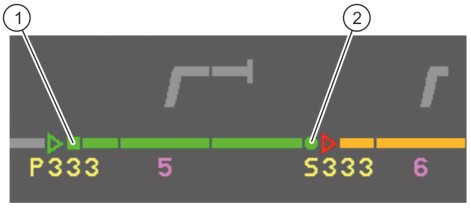Introduction
Documentation
Syntax
|
|
| Documentation
|
virtual logical object used for indication of route status on HMI
|
| Subschema
|
interlocking
|
| Parents*
|
routeStatusIndicators
|
| Children
|
designator (0..*), elementState (0..*), hasCommand (0..*), hasIndication (0..*)
|
Attributes:
- positionInRoute: This marks the position of the indicator in the route in case not clear by reference from routeEntry or routeExit. It is related to the functions the indicator will fulfil. (optional;
xs:string)
- Possible values:
- end: indicator is located at the end of the route path
- start: indicator is located at the start of the route path,
- elementNumber: number of the element in the set of interlocking data (optional;
xs:nonNegativeInteger),
- id: the identifier of the object; this can be either of type xs:ID or UUID (obligatory;
xs:ID); compare: Dev:Identities
|
*Notice:
Elements may have different parent elements. As a consequence they may be used in different contexts.
Please, consider this as well as a user of this wiki as when developing this documentation further.
Aspects that are only relevant with respect to one of several parents should be explained exclusively in the documentation of the respective parent element.
|
|
|
| Documentation
|
virtual logical object used for indication of route status on HMI
|
| Subschema
|
interlocking
|
| Parents*
|
routeStatusIndicators
|
| Children
|
designator (0..*), hasCommand (0..*), hasIndication (0..*)
|
Attributes:
- positionInRoute: This marks the position of the indicator in the route in case not clear by reference from routeEntry or routeExit. It is related to the functions the indicator will fulfil. (optional;
xs:string)
- Possible values:
- end: indicator is located at the end of the route path
- start: indicator is located at the start of the route path,
- elementNumber: number of the element in the set of interlocking data (optional;
xs:nonNegativeInteger),
- id: unique identifier (obligatory;
xs:string; patterns: (urn:uuid:)?[0-9a-fA-F]{8}-[0-9a-fA-F]{4}-[0-9a-fA-F]{4}-[0-9a-fA-F]{4}-[0-9a-fA-F]{12}|{[0-9a-fA-F]{8}-[0-9a-fA-F]{4}-[0-9a-fA-F]{4}-[0-9a-fA-F]{4}-[0-9a-fA-F]{12}}); compare: Dev:Identities
|
*Notice:
Elements may have different parent elements. As a consequence they may be used in different contexts.
Please, consider this as well as a user of this wiki as when developing this documentation further.
Aspects that are only relevant with respect to one of several parents should be explained exclusively in the documentation of the respective parent element.
|
This element does not appear in railML® 3.1 within the IL subschema. It is available only in railML® 3.2. Do not hesitate to contact railML.org for further questions.
Changes 3.1→3.2
There exists an overview of all changes between railML® 3.1 and railML® 3.2 on page Dev:Changes/3.2.
Introduced with version 3.2.
Changes 3.2→3.3
There exists an overview of all changes between railML® 3.2 and railML® 3.3 on page Dev:Changes/3.3.
The parents have been changed.
The children have been changed.
The attributes have been changed.
Semantics
Best Practice / Examples

For the safety of train traffic the used routes will have a life cycle with different stages. These stages are often indicated to the operator of a HMI of a controller. Typical two distinguished graphical symbols are used, one at the start and one at the end of the route. They are controlled as individual graphical objects.
- @elementNumber - A positive integer number unique within one <signalBox> to index the element in internal lists of engineering data.
- @id - The unique identifier used to reference this element within railML.
- @positionInRoute - This marks whether the indicator is at the start or the end.
- <hasCommand> - The reference to any predefined operator command, which can be used with this element. For details refer to <hasOperatorCommand>.
- <hasIndication> - The reference to any predefined indication on HMI, which is used with this element. For details refer to <hasHmiIndication>.
<rail3:routeStatusIndicator elementNumber="0" id="" positionInRoute="end">
<rail3:designator description="" entry="" register=""/>
<rail3:hasCommand entityCode="" ref=""/>
<rail3:hasIndication entityCode="" ref=""/>
</rail3:routeStatusIndicator>
Additional Information
Notes
Open Issues
